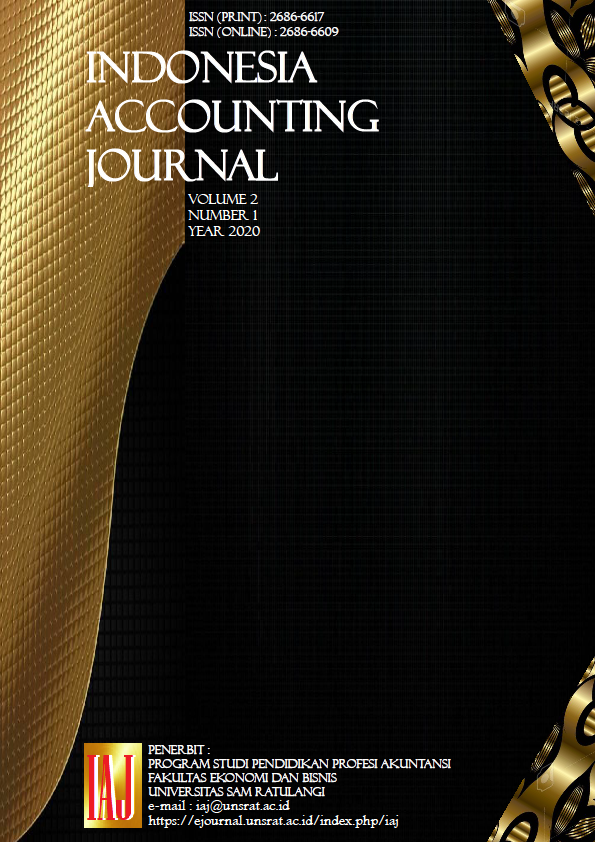Penentuan harga pokok produksi dengan menggunakan metode full costing pada Pembuatan Rumah Kayu (Studi kasus pada CV. Rajawali Tunggal Perkasa- Woloan 1 Utara)
DOI:
https://doi.org/10.32400/iaj.27557Keywords:
cost of production, full costing, basic cost of orderAbstract
The main cost of production was a direct and indirect amount of expenses and burdens, to produce goods or services under the right conditions and conditions for which they could be used or sold. This research was done on the CV Rajawali Tunggal Perkasa of a lumber company. The purpose of this study is to know how much profit is gained a measure of both income and sacrifice made. The kind of data used is qualitative data and the source data is the primary data. Results from studies indicate that the calculation of the principal production value to a CV Rajawali Tunggal Perkasa with a tally on the cost of production using the method full error indicates the difference of results. Based on the research, the main cost of production is based on the full yield method better at analyzing the cost of production, it is due to the calculation of principal prices of production by the full income method, not including the cost of administration and the cost of the car's rent into overhead, since those costs are a component of the company's profit assessment report.References
Bustami, B., & Nurlela. (2010). Akuntansi Biaya. Edisi Kedua. Jakarta: Mitra Wacana Media
Carter, W. K., & Usry, M. F. (2014). Akuntansi Biaya. Diterjemahkan oleh Krista. Buku 1. Edisi 14. Jakarta: Salemba Empat
Dunia, F. A., & Abdullah, W. (2012). Akuntansi Biaya. Jakarta: Salemba Empat
Firdaus, A. (2009). Akuntansi Biaya. Edisi 2. Jakarta: Salemba Empat
Krismiaji, & Aryani Y., A. (2011). Akuntansi Manajemen. Yogyakarta: Unit Penerbit Dan Pencetakan Sekolah Tinggi Ilmu manajemen YKPN.
Harnanto. (2017). Akuntansi Biaya : Sistem Biaya Historis. Yogyakarta: BPFE
Kamaruddin, A. (2013). Akuntansi manajemen. Edisi Revisi, Cetakan Ke Delapan. Jakarta: Raja Grafindo Persada.
Kuncoro, M. (2003). Metode Riset untuk Bisnis dan Ekonomi : Bagaimana Meneliti dan Menulis Tesis?. Jakarta: Erlangga.
Mulyadi. (2014). Sistem Akuntansi. Cetakan Keempat. Yogyakarta: Sekolah Tinggi Ilmu Manajemen YKPN
Mulyadi. (2015). Akuntansi Biaya, Edisi 5. Yogyakarta: Sekolah Tinggi Ilmu Manajemen YKPN
Samamora, H. (2013). Akuntansi Manajemen. Edisi III. Jakarta: Stard Date Publisher.
Siregar, B., Suripto, B., Hapsoro, D., Widodo Lo, E., Herowati, E., Kusumasari, L., & Nurofik. (2016). Akuntansi Biaya. Jakarta: Salemba Empat
Sugiyono. (2014). Metode Penelitian Pendidikan Pendekatan Kuantitatif, Kualitatif, dan R&D. Bandung: Alfabeta.
Sujarweni, V. W. (2015). Akuntansi Biaya : Teori Dan Penerapannya. Yogyakarta: Pustaka Baru Press.
Supriyono. (2011). Akuntansi Biaya : Pengumpulan Biaya dan Penentuan Harga Pokok. Edisi kedua. Cetakan Kelima belas. Yogyakarta: BPFE.
Downloads
Additional Files
Published
Issue
Section
License
The articles published in Indonesia Accounting Journal are licensed under Creative Commons Attribution 4.0 International License with authors as copyright holders.
Â

This work is licensed under a Creative Commons Attribution 4.0 International License.
Â
Under this license then authors free to:
- Share — copy and redistribute the material in any medium or format.
- Adapt — remix, transform, and build upon the material for any purpose, even commercially.
Under the following terms :
- Attribution — You must give appropriate credit, provide a link to the license, and indicate if changes were made. You may do so in any reasonable manner, but not in any way that suggests the licensor endorses you or your use.
- No additional restrictions — You may not apply legal terms or technological measures that legally restrict others from doing anything the license permits.
Notices:
- You do not have to comply with the license for elements of the material in the public domain or where your use is permitted by an applicable exception or limitation.
- No warranties are given. The license may not give you all of the permissions necessary for your intended use. For example, other rights such as publicity, privacy, or moral rights may limit how you use the material.


